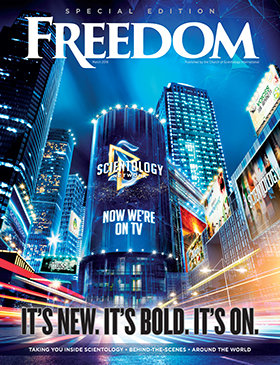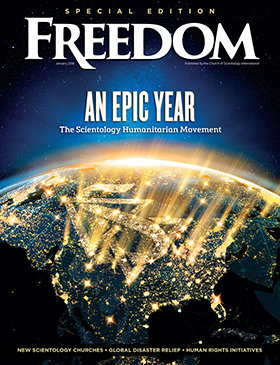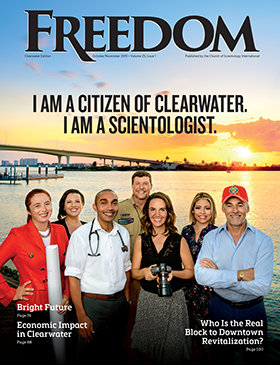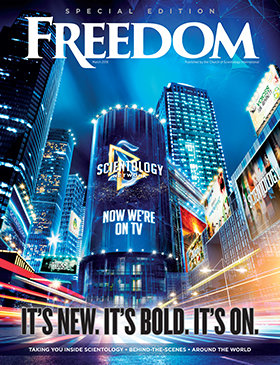Salvaging the planet is a tough job—but the Churches that can make it happen are being built.
There are days of rage, when humanity recoils in horror at bloodshed and depravity. Poignant are the sneak attacks on America—December 7, 1941, and September 11, 2001—which so stunned the world. But for only a short time.
In 1945, the Allied nations smashed the Axis powers. And, while the outcomes of “9/11” are still playing out, there was no argument that many good men and women said “no!” to a future that held only carnage and chaos.
Among those who refused to capitulate to fear after 9/11, the Church of Scientology marshaled its resources to salvage civilization from its mad rush towards self-destruction. “Bluntly, we are the only people on Earth who can reverse the decline,” stated Scientology’s ecclesiastical leader, David Miscavige, in a message titled “Wake-Up Call” that was sent to every member of the religion just hours after the World Trade Center towers fell. “If we don’t work faster we could face a scenario where any help would be impossible. And it’s not just the violence we have recently witnessed; it’s everything that violence potentially wreaks in terms of economic and social collapse.”
The key to answering that challenge was in transforming every Scientology Church into powerhouses of outreach.
Yes, the Churches serve their members, advancing them up what’s called the “Bridge to Total Freedom.” But an equally important role is organizing crusades and programs—in tandem with many other groups—that attack the causes of degradation in society. These humanitarian efforts fight drugs, advance literacy, promote human rights, battle psychiatric abuse and teach rehabilitation for ex-offenders. And squads of Scientology Volunteer Ministers respond to everything from the devastation of earthquakes to organizing “extreme” tours to remote communities that are in dire need of social services.
The challenge in 2001 was that few of Scientology’s Churches had the brick and steel, and precise design, to do the work envisioned in Mr. Miscavige’s “Wake-Up Call.” Scientology was founded in the mid-20th century, and had expanded rapidly. A lot of the early Church structures weren’t up to the task.
Mr. Miscavige had a study done of the Tampa Church, close to the Church’s spiritual headquarters in Clearwater, Florida, and out of that came a plan.
“People said we couldn’t create the Churches that we needed,” said Mr. Miscavige. “People said we should do things gradually.
“But that got us nowhere, and buildings have taken too long to plan, construct and open—while humanity’s plunge into chaos hasn’t slowed. We had to act,” Mr. Miscavige concluded.
His energy echoed that of Scientology Founder L. Ron Hubbard, when he said in 1982: “The consideration that it takes a long time to build something is not true. That itself is an aberration, an effort to discourage destruction by pretending creation takes a long time.”
Building Ideal Churches was not a new concept. Indeed, it was the vision of Mr. Hubbard as early as 1962: “We’re thinking in terms of new buildings and designing new buildings all over the world.” And in 1975 when he described the Ideal Organization: “One could look at this ideal org and know that this was the place a new civilization was being established for this planet.”





It was in 2003 when the first Ideal Church (or Organization) was created. With the opening of the new Church in Atlanta in April 2016, Scientology reached a milestone of 51 new Ideal Orgs. How did that happen?
Mr. Miscavige determined exactly what must be done to build an Ideal Org—the kind described by Mr. Hubbard. The Church at Saint Hill in England, which Mr. Hubbard managed while also conducting advanced spiritual research in Scientology in the mid-1960s, was a model to attain that was set by Mr. Hubbard. But how could that be measured? The solution was determined by desired outcomes—here’s everything an Org should do, and here’s how the physical planning could achieve that. It’s not just the size, but the rigorously designed plans that enable the broad dissemination of the religion and the delivery of all available Scientology services, thus allowing Scientologists to accelerate their spiritual progress.
Achieving incredibly precise quality, as well as economic efficiency, were considerations. “It was an overwhelming task if every single Church had to plan out its work individually,” Mr. Miscavige said. “We had to organize it so that Churches were not left on their own to solve the same construction problems which come up in each case, while bringing down the cost with global procurement contracts.”
The answer was the International Landlord Office which was created as the management body to oversee the creation of Ideal Orgs globally.
The mandate was to do it all and do it all now. The mass purchasing and standardization by master designers—especially the worldwide architectural firm of Gensler—had to be integrated with the sense and style of each community.
“With what we’re doing centrally,” Mr. Miscavige said, “we are helping every Church congregation. By unifying functions such as space planning, design and purchasing, we don’t duplicate work. We maximize the economy and we assist every Church to achieve the highest quality building.”
The first Ideal Church was in Johannesburg, South Africa, opening on November 1, 2003. The city was one in which Mr. Hubbard lived and continued his research into the spirit and mind in the early 1960s. To inaugurate the Ideal Church program, Mr. Miscavige highlighted the mission of Scientology, salvaging mankind.
Mr. Hubbard tackled problems “directly and at every strata,” Mr. Miscavige said at the Johannesburg opening, “from programs for white juvenile delinquents, to literacy tools for black African schools, not to mention an end to the policy of separateness. … LRH knew those chains would be broken, and yet the freedom sought would not be achieved without something else. For, how free is a man if he is not able. And that is why, above all else, he worked to bring the spiritual freedom that is only possible through the Technology of Scientology.”
Fifteen days later, Mr. Miscavige opened the second Ideal Church—this one in Buffalo, N.Y. At the inauguration, David Miscavige announced: “Here stands the Central Organization to bring our solution of drug rehabilitation, education, morality, not to mention even more groups, centers and missions to every community.”
After that came San Francisco, where Mr. Miscavige announced the “workable solutions” embedded in this new Church, and the mission to “bring them everywhere, on a planetary scale, to reverse those trends” of social decay.
And then on to Madrid, London, Rome, Nashville, Seattle, Portland, Tokyo—until the Church reached No. 51, Atlanta. And the runway for new Ideal Churches keeps increasing in speed, with 50 more planned to be opened in the immediate future.
Mr. Miscavige summed up: “What LRH envisioned of an Ideal Church is a gathering place for the entire community. Yes, it is the ideal facility to service Scientologists on their ascent to higher states of spiritual freedom. But it is also the meeting point for humanitarian programs in that city for the benefit of all, a cooperative effort to uplift people of all denominations. And, ultimately, we reach the point where humanity finally has a chance.”








































